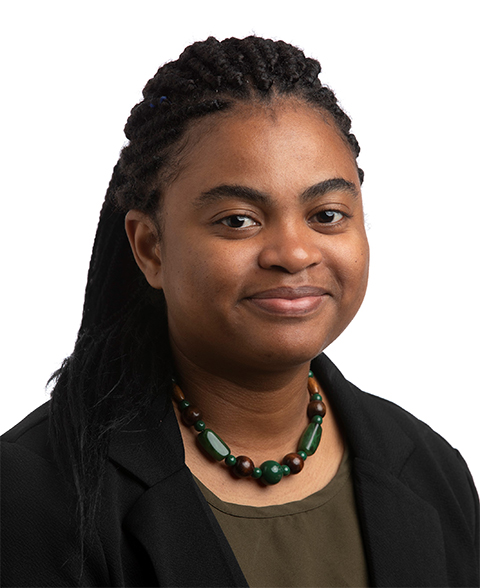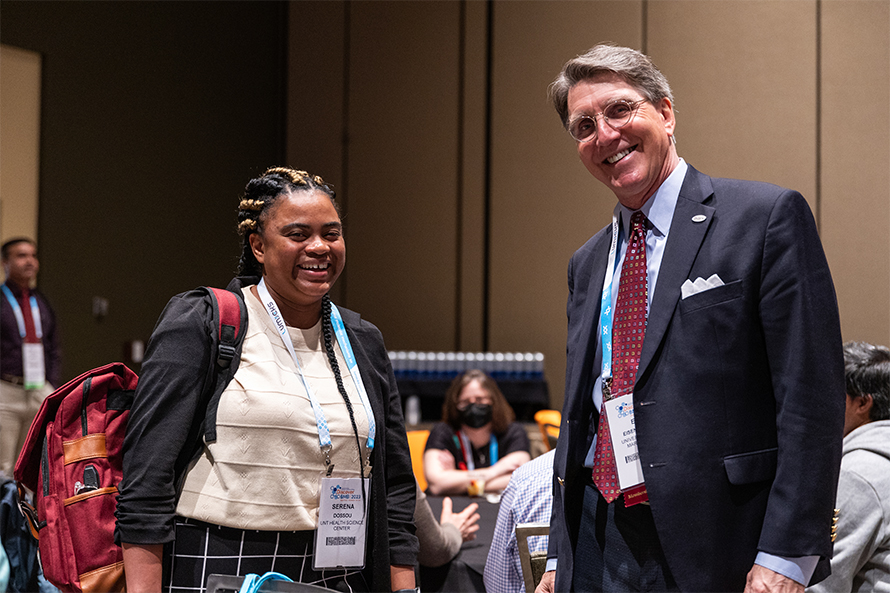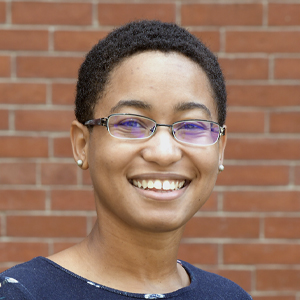Uncertain Ph.D. path ends with a sprint to an industry job
Akpedje Serena Dossou explains her research with incandescent enthusiasm. An expert in tumor immunology, macrophage biology and nanoparticle technology, she conveys the importance of her scientific findings and the joy of uncovering them with a contagious smile.
Her love of research was a discovery in and of itself. Dossou entered the field as a master’s student at the University of North Texas Health Science Center, or UNTHSC, wanting to find out whether a career as a scientist was right for her.

“At that time, I wasn’t too sure if I really wanted to commit to several years of completing my Ph.D., so I completed my master’s first,” Dossou said.
Although her family wholeheartedly supported her academic ambitions, being a first-generation college student presented an obstacle.
“I did not have a close reference for a Ph.D. … someone who had undergone graduate school, who could help me visualize challenges, success and a career with a Ph.D.,” Dossou said. “From my inquiries with graduate students, faculty and academic advisors, I knew grad school could be challenging ... At that point getting a Ph.D. was somewhat akin to reaching for the stars, and I wasn’t sure I had the stamina (both financially and intellectually) for the journey.”
While earning her master’s, Dossou worked in Andras G. Lacko’s lab, working to improve delivery methods for the cancer drug valrubicin, also known as Valstar. Valrubicin does not dissolve easily in water, and the formulation used to dissolve it is toxic. Its use is, therefore, restricted to sites where it can be directly delivered, such as the bladder, so it doesn’t spread throughout the body. Improving its solubility could extend its applications to harder-to-access malignancies.
Dossou tried different types of nanoparticles as carrier molecules for the drug. One of these was albumin, the most abundant protein in plasma, which improves the solubility of another chemotherapeutic, paclitaxel. By adding albumin to the mix, Dossou found she could increase valrubicin’s solubility, making strides toward a safer and more effective delivery formulation.
This work fueled Dossou’s curiosity and propelled her to tackle more problems related to cancer treatment. After graduating with a master’s degree in biomedical sciences, she began working on her doctoral degree.
“After I found out that I really enjoy research, I was ready to delve into it,” she said. “During the completion of my master’s degree, I came to a greater appreciation of biomedical research not only because of the impact it has on the betterment of disease prevention and patient care but also the personal growth I experienced through the skills I gained and the values it reinforced in me. In addition to this, the diverse and supportive research environment provided by Dr. Lacko further encouraged me to pursue a Ph.D.”
A Ph.D. with three PIs
As a doctoral student, Dossou set her sights on tumor macrophages. Macrophages near tumors can call in other immune cells and help drive an inflammatory response to eradicate the cancerous cells, but over time, tumors can send out signals that convert the macrophages to their cause.
“Initially, they tend to react to the tumor, but as time progresses, they become a bit more immunosuppressive in nature,” Dossou said. “They are one of the immune cell types that drive immunosuppression in cancer, and they can promote cancer growth as well as metastasis.”
Dossou’s goal was to revert the macrophages back to an antitumor state, and she used her expertise in nanoparticle science to achieve it.
Macrophages are known to take up excess high-density lipoprotein, or HDL, and transport it to the liver to prevent its buildup in blood vessels, so Dossou used HDL to make nanoparticles and loaded them with a drug that would promote an antitumor inflammatory response. Knowing that tumor-associated macrophages have a surface receptor for a sugar called mannose, she also decorated the nanoparticles with this sugar, hypothesizing that this innovation would improve drug uptake. Her results supported this hypothesis; Dossou successfully converted macrophages to an inflammatory state, driving them to target ovarian cancer cells in culture while sparing healthy cells.
Throughout this research, a number of mentors supported Dossou. When Lacko retired in 2020, during the COVID pandemic, Rafal Fudala took over the lab.
“Like my previous mentor, he really molded me as a scientist,” Dossou said. “His energy and passion for research were contagious. Although our lab activities came to a temporary halt during COVID, his leadership and collaborative spirit enabled us to initiate collaborations, plan research and publish complete research, and gave a momentum to our lab activities, including my Ph.D. project, past the COVID pandemic.”
In 2022, Fudala died suddenly at the age of 46 while on a camping trip with his family.
While processing the emotional impact of her mentor’s death, Dossou managed to continue moving her project forward. “In the midst of the shock and grieving, our departmental support and the encouragement of peers and faculty kept me going,” she said.
After Fudala’s death, a member of Dossou’s dissertation advisory committee, Rance Berg, stepped in as her principal investigator. She had previously attended Berg’s journal club sessions and found them informative and enjoyable, and she said his in-depth knowledge of and experience in immunology were excellent resources. Andras Lacko, her advisor when she was a master’s student, also lent guidance and support.
Having earned a scholarship from the Health Science Center Scholars in Cancer Research program, Dossou also received funding from to Cancer Prevention and Research Institute of Texas. By covering her stipend and some of her tuition and research costs, the scholarship helped to alleviate the financial burden that Ph.D. students can face when they lose their primary mentor.
Mentoring lessons
In addition to guiding Dossou in her doctoral research, both Fudala and later Berg encouraged her to develop her own skills as a mentor by teaching junior lab mates, from undergraduates to rotating Ph.D. students. Dossou said two of these mentees, Morgan Mantsch and Ammar Kapic, were instrumental in delivering results on her project.
“There are learning and growth opportunities for both sides in a mentor–mentee relationship,” she said. “I found myself gradually adjusting my mentoring to the unique academic needs of students, revisiting my perspectives and keeping up with the rapid evolution of my field to provide more effective guidance.”
For example, she said she assumed one undergraduate student had the immunology background they needed for their project. But it turned out they were struggling with that aspect. Seeing this, Dossou shared academic resources, provided explanations and then checked on the student’s understanding as they moved through the project.
“This experience further solidified my understanding of some concepts and taught me to keep an eye out for the unique academic backgrounds of my mentees in the future,” Dossou said.
She also acted as a peer mentor outside her research group, through a program that connected incoming graduate students with more senior peers whose experience matched their interests. As someone with experience transitioning from a master’s to a Ph.D., Dossou was happy to meet with and advise students considering a similar path.

Outside the lab
As a peer mentor, Dossou encouraged her mentees to get involved in student organizations. When she was a master’s student, she saw how friends who participated in on-campus groups and activities viewed their roles as scientists in a societal context.
“I found out that because they were so involved in these activities, they had an interesting way of looking at things,” she said. “They cared about their peers; they cared about how the institution was meeting our needs. They advocated for us.”
Seeing the impact her peers had during her master’s spurred Dossou to become more involved. Outside the lab, she participated in HSC4Life, an organization that fosters connections between students and alumni. She served as representative-at-large, then vice-president, then president of the university’s Graduate Student Government Association. As a representative-at-large, she connected with students in other leadership roles in student government as she worked with them to organize events. These conversations prepared her to head the association a few years later. She also volunteered at a local food bank.
Dossou also saw students engage with organizations outside the university, such as the American Heart Association. “It looked as though that helped them connect better,” she said, “to connect their science with those who are going to benefit, which is actually all of us, the entire population.”
Dossou’s desire to be a positive force in the broader scientific community led her to join the American Society for Biochemistry and Molecular Biology in 2018. She later joined the ASBMB Membership Committee and began to share her perspective on how best the ASBMB could support its members in graduate school.
“Being on the committee has greatly enriched my graduate experience by getting me acquainted with the evolving membership needs of the research community, edifying my communication and advocacy skills, widening my professional network and more,” she said.
The sprint to industry
About seven months before Dossou completed her Ph.D. program, she took a forward-thinking approach to job hunting. Setting her sights on a career in industry, she balanced completing her dissertation research with networking. She said informational interviews and networking at conferences — especially the ASBMB annual meeting — were key to learning what it would take to be competitive in the industry job market.
Right after Dossou defended her dissertation, a UNTHSC alum shared information about a job opening in research and development at the Sonic Reference Laboratory. The job focused on assay development for clinical diagnostics, which was a perfect fit for her skill set and desire to help patients through her research. She successfully applied and made a seamless jump from graduate school into the industry career she had been working toward.
Now a senior core laboratory development scientist at the Sonic Reference Laboratory, Dossou is continuing her work in translational medicine. She remains an active member of the ASBMB Membership Committee and continues to build community among her fellow scientists.
Enjoy reading ASBMB Today?
Become a member to receive the print edition four times a year and the digital edition monthly.
Learn moreFeatured jobs
from the ASBMB career center
Get the latest from ASBMB Today
Enter your email address, and we’ll send you a weekly email with recent articles, interviews and more.
Latest in People
People highlights or most popular articles

In memoriam: Michael J. Chamberlin
He discovered RNA polymerase and was an ASBMB member for nearly 60 years.

Building the blueprint to block HIV
Wesley Sundquist will present his work on the HIV capsid and revolutionary drug, Lenacapavir, at the ASBMB Annual Meeting, March 7–10, in Maryland.

In memoriam: Alan G. Goodridge
He made pioneering discoveries on lipid metabolism and was an ASBMB member since 1971.

Alrubaye wins research and teaching awards
He was honored at the NACTA 2025 conference for the Educator Award and at the U of A State and National Awards reception for the Faculty Gold Medal.

Designing life’s building blocks with AI
Tanja Kortemme, a professor at the University of California, San Francisco, will discuss her research using computational biology to engineer proteins at the 2026 ASBMB Annual Meeting.

Jordahl named Gilliam Fellow
He will receive three years of funding to support his thesis research.

